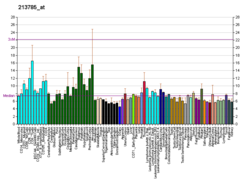| IPO9 |
|---|
|
| Mã định danh |
|---|
| Danh pháp | IPO9, Imp9, importin 9 |
|---|
| ID ngoài | HomoloGene: 5874 GeneCards: IPO9 |
|---|
|
| Bản thể gen |
|---|
| Chức năng phân tử | • GO:0031493 histone binding
• GO:0001948, GO:0016582 protein binding
• nuclear import signal receptor activity
|
|---|
| Thành phần tế bào | • tế bào chất
• membrane
• nhân tế bào
• nuclear envelope
• cytosol
|
|---|
| Quá trình sinh học | • protein transport
• intracellular protein transport
• protein import into nucleus
• GO:0015915 transport
|
|---|
| Nguồn: Amigo / QuickGO |
|
| Gen cùng nguồn |
|---|
| Loài | Người | Chuột |
|---|
| Entrez | | |
|---|
| Ensembl | | |
|---|
| UniProt | | |
|---|
| RefSeq (mRNA) | | |
|---|
| RefSeq (protein) | | |
|---|
| Vị trí gen (UCSC) | n/a | n/a |
|---|
| PubMed | [1] | n/a |
|---|
| Wikidata |
|
Importin-9 là protein ở người được mã hóa bởi gen IPO9.[2][3][4]
Tham khảo
- ^ “Human PubMed Reference:”.
- ^ Jakel S, Mingot JM, Schwarzmaier P, Hartmann E, Gorlich D (tháng 2 năm 2002). “Importins fulfil a dual function as nuclear import receptors and cytoplasmic chaperones for exposed basic domains”. EMBO J. 21 (3): 377–86. doi:10.1093/emboj/21.3.377. PMC 125346. PMID 11823430.
- ^ Hirosawa M, Nagase T, Ishikawa K, Kikuno R, Nomura N, Ohara O (tháng 1 năm 2000). “Characterization of cDNA clones selected by the GeneMark analysis from size-fractionated cDNA libraries from human brain”. DNA Res. 6 (5): 329–36. doi:10.1093/dnares/6.5.329. PMID 10574461.
- ^ “Entrez Gene: IPO9 importin 9”.
Đọc thêm
- Zhang QH, Ye M, Wu XY, và đồng nghiệp (2001). “Cloning and Functional Analysis of cDNAs with Open Reading Frames for 300 Previously Undefined Genes Expressed in CD34+ Hematopoietic Stem/Progenitor Cells”. Genome Res. 10 (10): 1546–60. doi:10.1101/gr.140200. PMC 310934. PMID 11042152.
- Mühlhäusser P, Müller EC, Otto A, Kutay U (2001). “Multiple pathways contribute to nuclear import of core histones”. EMBO Rep. 2 (8): 690–6. doi:10.1093/embo-reports/kve168. PMC 1084005. PMID 11493596.
- Strausberg RL, Feingold EA, Grouse LH, và đồng nghiệp (2003). “Generation and initial analysis of more than 15,000 full-length human and mouse cDNA sequences”. Proc. Natl. Acad. Sci. U.S.A. 99 (26): 16899–903. doi:10.1073/pnas.242603899. PMC 139241. PMID 12477932.
- Lubert EJ, Sarge KD (2003). “Interaction between protein phosphatase 2A and members of the importin beta superfamily”. Biochem. Biophys. Res. Commun. 303 (3): 908–13. doi:10.1016/S0006-291X(03)00434-0. PMID 12670497.
- Ota T, Suzuki Y, Nishikawa T, và đồng nghiệp (2004). “Complete sequencing and characterization of 21,243 full-length human cDNAs”. Nat. Genet. 36 (1): 40–5. doi:10.1038/ng1285. PMID 14702039.
- Bouwmeester T, Bauch A, Ruffner H, và đồng nghiệp (2004). “A physical and functional map of the human TNF-alpha/NF-kappa B signal transduction pathway”. Nat. Cell Biol. 6 (2): 97–105. doi:10.1038/ncb1086. PMID 14743216.
- Gerhard DS, Wagner L, Feingold EA, và đồng nghiệp (2004). “The Status, Quality, and Expansion of the NIH Full-Length cDNA Project: The Mammalian Gene Collection (MGC)”. Genome Res. 14 (10B): 2121–7. doi:10.1101/gr.2596504. PMC 528928. PMID 15489334.
- Kimura K, Wakamatsu A, Suzuki Y, và đồng nghiệp (2006). “Diversification of transcriptional modulation: Large-scale identification and characterization of putative alternative promoters of human genes”. Genome Res. 16 (1): 55–65. doi:10.1101/gr.4039406. PMC 1356129. PMID 16344560.
 | Bài viết về một gen trên nhiễm sắc thể 1 ở người này vẫn còn sơ khai. Bạn có thể giúp Wikipedia mở rộng nội dung để bài được hoàn chỉnh hơn. |














